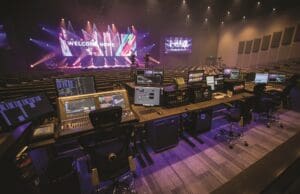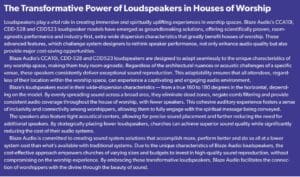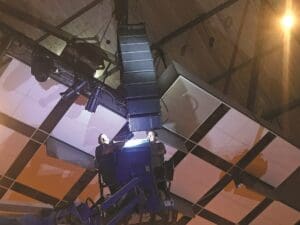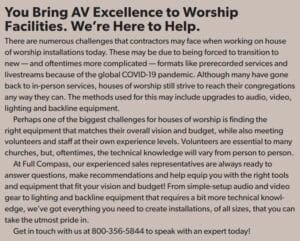Commercial Integrator Deep Dive reports exist to provide an overview of an entire vertical market or technology category, identifying overarching trends and exploring common pain points. Houses of worship pose a challenge in this regard, as the worship market presents numerous divergences. As you’ll see here, even our own interviewees, who are deeply connected to the worship community, draw different conclusions in some cases. And, of course, there is a vast gulf between cash-flush churches (e.g., Lakewood Church) and the Baptist church down the street. Thus, this Deep Dive is unlikely to provide much guidance of the “one-size-fits-all” variety. However, it will provide perspective to help you determine whether the worship market is right for your integration company, and it’ll offer critical insights on how to maximize your chances of success in it.
CI recruited a top worship-market integrator, David Lee, PhD, president of Lee Communication Inc., to share his views of the space. Lee has served houses of worship for decades, and his projects’ geographical breadth attests to his expertise. Right now, Lee Communication Inc.’s work spans from Nashville, Tenn.; to Miami; to Ecuador; to Liberia; to Vietnam. CI also sought out Brandon Creel, CR-T, CEE, CTS-D, partner at leading consultancy Hewshott. His organization does quite a bit of worship-related work. And, in fact, Creel earned an invitation to speak at a church conference last November. CI also surveyed a representative sample of the integration community to get a wider view of this market segment. Select survey data is interspersed throughout this article.
Capturing Houses of Worship with Bolin PTZ Cameras
Houses of worship are a unique, challenging and exciting environment for video capture. Many houses of worship have vocalists, praise bands and choirs on platforms that incorporate dramatic lighting that shifts in color and intensity throughout the worship experience. Other worship environments combine natural and tasteful architectural light with far less motion on the platform. Most houses of worship are somewhere in between. No matter the style or the liturgy, almost all houses of worship now need to capture the service for display within the facility and for streaming to those who attend remotely. Bolin believes PTZ cameras are an ideal fit for all houses of worship as primary video sources or as valuable additions to staffed broadcast cameras.
Our new Blue Line cameras have smooth, quiet motors and clear, crisp images with all the essential features, such as multiple, simultaneous HDMI, USB and IP streaming outputs, all at budget-friendly prices. Our Red Line cameras are designed for houses of worship with higher-end broadcast environments and offer additional features, such as full Sony image blocks, up to 12G-SDI and Genlock. For houses of worship using Dante, Bolin offers a comprehensive line of Dante AV Ultra products, including transceivers, and Dante AV Ultra-native PTZ cameras. And our KBD-1010 PTZ keyboard can control them all.
Bolin is excited about houses of worship and what we can offer to help them capture and stream their services.
Houses of Worship Post-COVID-19
Lots of journalists and societal observers seem to be wringing their hands about people having a “crisis of faith” and churches closing as a result. According to Lee, those worries don’t match the reality on the ground. “I don’t think as many are closing as it might seem,” he says. Lee draws an analogy to COVID-19, explaining that, much as the virus had a worse effect on people with preexisting conditions, the pandemic had the same amplified effect on churches suffering from underlying issues. “Honestly, in some cases, it just gave those particular churches an opportunity to have a reason to close,” he says candidly. Lee adds that lots of churches seized on that downtime to make key upgrades. “We stayed 150% busy through the whole crisis,” he shares.
And those very upgrades are a central part of what’s drawing congregants back to in-person worship. Creel describes churches purchasing refreshed audio, video and lighting as “…investing in their clientele to bring them back.” According to Lee, “People are tired of staying in their pajamas and watching church. They want to be around people again.” However, he notes, in our media-saturated society, it’s incumbent on church leadership to create an experience that’s worth leaving home for — one that will bring people back to the sanctuary. And even with some churches shutting their doors for lack of congregants or insufficient financial support, it’s still true that every town and village has numerous worship centers from which to choose. “The church market is competing against one another to offer something to their congregation,” Creel observes. Integration businesses can provide those differentiators.
Lee remarks on competition among churches, saying the vertical has a “keeping up with the Joneses” tendency. Leaders tend to think, “If the church down the street has a DVLED videowall, why don’t we have one?” If your business plays in this space, this presents a clear opportunity for you.
Being a Trusted Partner
Although integrators and consultants are, of course, in business to earn a living, successful ones don’t merely see job prospects when they look at the worship market; more importantly, they see the chance to meaningfully help people. “The church market is not a one-size-fits-all,” Creel declares. “Don’t go in there and think if you’ve done one church, you can do them all. That’s totally not true.” Lee agrees, discussing how he courts prospective clients. “I’ll study that church,” he explains. “I’ll watch their YouTube videos. I’ll watch what they’re doing. I’ll visit them. Whatever it takes to see what their needs are.” He explains that the primary point of contact is usually the pastor or the worship leader, the latter term referring to the individual who puts together the music experience. Lee emphasizes the need to study both, and then tailor your pitch to their respective needs.

These days, churches have embraced theatrical-style production techniques for in-person audiences and remote congregants who watch via the livestream. Photo courtesy Mankin Media/Tim Corder.
The pastor will be most compelled by how technology can help them present their sermon or teachings more effectively. A savvy integrator, for example, will notice that a handheld microphone is an encumbrance to the pastor and suggest an over-the-ear mic. By contrast, conversations with the worship leader will likely center on optimizing musical elements, like soloists, a choir or a praise band. Lee offers the example of attending sound check, hearing feedback and recommending wireless IEMs to mitigate the problem. “It’s helping them to understand how they can really use the technology without it overwhelming them,” he emphasizes.
Creel stresses that the church market is a tight-knit community in which relationships are paramount. “We do find that we do get referrals from one to another,” he explains. “They’re really just looking for someone to help out.” That means it’s essential to present yourself well and earn the leaders’ trust. Lee references something he calls “the rearview mirror test.” In short, you should ask yourself if you look good, sound good and are ready to make a great impression. In the live-sound world, socializing over drinks at the bar is great; if you’re talking to a church leader, though, it’s better to err on the side of conservatism. “The technology is not really the thing to get you in the door,” Lee states. “It’s really about having the ability to understand your client.”
The Message is Paramount
Unsurprisingly, both of our experts agree on integrators’ paramount responsibility when working with houses of worship. “Sound is of number-one importance,” Creel states. “They want to get it right.” That means technical systems must effectuate intelligible audio, deliver even coverage from front to back, and ensure that both music and speech come through clearly. And, when it comes to delivering on that, Lee has a go-to answer. “Line array, right now, is the thing,” he declares. “It’s not that it’s the only thing, but the line array solves a lot of issues with intelligibility and distribution.”
 According to Lee, traditional point-source solutions have always had a place, but they’ve also had longstanding limitations. “It was mostly geared for speech,” he explains. “Today, you’ve got to have a sound system that’s for the full range: music and speech.” Lee also praises line arrays for their relative ease of deployment, and he points to the helpfulness of high-quality prediction software (e.g., EASE, manufacturers’ proprietary offerings). “Today, it has become so sophisticated,” he marvels. “It’s pretty accurate on where the speakers need to be located.” Indeed, Lee adds that today’s software is precise enough to calibrate the pitch of the speakers on the array. However, he makes clear that not all “line arrays” actually adhere to true line-array theory. Lee praises Meyer Sound, L-Acoustics and d&b audiotechnik for being truly effective.
According to Lee, traditional point-source solutions have always had a place, but they’ve also had longstanding limitations. “It was mostly geared for speech,” he explains. “Today, you’ve got to have a sound system that’s for the full range: music and speech.” Lee also praises line arrays for their relative ease of deployment, and he points to the helpfulness of high-quality prediction software (e.g., EASE, manufacturers’ proprietary offerings). “Today, it has become so sophisticated,” he marvels. “It’s pretty accurate on where the speakers need to be located.” Indeed, Lee adds that today’s software is precise enough to calibrate the pitch of the speakers on the array. However, he makes clear that not all “line arrays” actually adhere to true line-array theory. Lee praises Meyer Sound, L-Acoustics and d&b audiotechnik for being truly effective.
Creel is first to point to a relevant truism. As he puts it, “A sound system is only as good as the acoustics of the room.” And, Creel notes, Hewshott never overlooks that fact. “Because we do acoustics, as well, we also incorporate acoustical solutions into our sound-system replacement, upgrade, enhancement or installation,” he says. Lee describes acoustically treating the sanctuary as absolutely essential. He laments that some church clients are ready to spend $500,000 or $1 million on a state-of-the-art sound system without really considering the acoustical properties of the room. “We can sell you the best line array in the world,” Lee begins, “but it’s not going to sound good if your room is not treated.” Thus, he urges all integrators to build strong relationships with acousticians.
Implementing Dazzling Video
Video systems are a place where integrators can really lean into the role of consultative partner. That’s because numerous high-quality options exist (e.g., DVLED videowalls, tiled LCD and projection), as well as because prices vary considerably based on factors like size, pixel pitch and brightness level. “We always look at it this way,” Creel begins. “What are the needs? What are we trying to accomplish? And then we can help budget and, ultimately, design and implement a solution that will work in the space.” He says it’s critical to tether the video deployment to a set of goals. “You know, large enough and bright enough video that everybody can see,” Creel remarks. “You shouldn’t be squinting to try to see the video.” Thus, integrators should lead a conversation about sight lines, the benefits of projection versus those of DVLED, etc.
 Display formats represent the first major area of disagreement among our experts. According to Creel, “You typically get better bang for the buck with projection, and then we can use that money to upgrade or enhance lighting or acoustics or sound.” He says that, with some church clients, there’s worry that investing in DVLED could cannibalize a large share of their overall tech budget. Meanwhile, Lee has a different take. “I haven’t sold a projector in I couldn’t tell you how long,” he says. “The LED wall thing is just on fire right now.” Lee also argues that the price gap between projection and DVLED isn’t what it once was. He says that a 16’x9’ DVLED wall and a 12,000-lumen-plus projector, creating an image roughly the same size, would both likely be in the $40,000 to $50,000 range. Harking back to the “keeping up with the Joneses” point he made earlier, Lee adds, “If a church really wants something, they seem to be able to find the money.”
Display formats represent the first major area of disagreement among our experts. According to Creel, “You typically get better bang for the buck with projection, and then we can use that money to upgrade or enhance lighting or acoustics or sound.” He says that, with some church clients, there’s worry that investing in DVLED could cannibalize a large share of their overall tech budget. Meanwhile, Lee has a different take. “I haven’t sold a projector in I couldn’t tell you how long,” he says. “The LED wall thing is just on fire right now.” Lee also argues that the price gap between projection and DVLED isn’t what it once was. He says that a 16’x9’ DVLED wall and a 12,000-lumen-plus projector, creating an image roughly the same size, would both likely be in the $40,000 to $50,000 range. Harking back to the “keeping up with the Joneses” point he made earlier, Lee adds, “If a church really wants something, they seem to be able to find the money.”
Major Changes in Church Lighting
According to Lee, there’s a throughline between the ascendance of DVLED and investment in other technology areas. “The surge [in LED lighting fixtures] has really come with the adoption of the DVLED wall,” he observes. Describing the move away from traditional PAR cans and toward LED lighting as “…one of the hottest upgrades going through the pandemic and even before,” Lee says failure to make the necessary lighting upgrades risks having the images on your DVLED wall look “horrible.” He comments that church leaders have discovered that “…when I use my traditional PARs at 3200 Kelvin, my pastor looks red on the LED wall.” Unsurprisingly, then, Lee Communication has made a tidy business of swapping out old PAR cans. In fact, Lee says, his company has installed between 500 and 800 LED fixtures in recent years.
 LED fixtures prove their benefit in numerous ways, including with respect to affordability, energy efficiency and improved aesthetics. By Lee’s reckoning, 10 years ago, the cheapest good-quality moving light might have been $10,000. By contrast, today, you can get one for $1,500. “There are products on the market [where] the LED experience makes a lot more sense because they’re affordable, and yet they do a good job,” he says. On the topic of environmental stewardship — not to mention avoiding waste — Lee says the shift away from PAR cans brings electricity costs way down. Indeed, by swapping an LED fixture for a 1,000-watt PAR, he declares, “…you can get by with typically 300 watts or less.” Finally, according to Lee, LED fixtures give sanctuaries a newer, fresher, more advanced look. This aligns with the imperative to make out-of-home venues experiential destinations.
LED fixtures prove their benefit in numerous ways, including with respect to affordability, energy efficiency and improved aesthetics. By Lee’s reckoning, 10 years ago, the cheapest good-quality moving light might have been $10,000. By contrast, today, you can get one for $1,500. “There are products on the market [where] the LED experience makes a lot more sense because they’re affordable, and yet they do a good job,” he says. On the topic of environmental stewardship — not to mention avoiding waste — Lee says the shift away from PAR cans brings electricity costs way down. Indeed, by swapping an LED fixture for a 1,000-watt PAR, he declares, “…you can get by with typically 300 watts or less.” Finally, according to Lee, LED fixtures give sanctuaries a newer, fresher, more advanced look. This aligns with the imperative to make out-of-home venues experiential destinations.
Livestreaming Remains Essential
Even if a church invests in the best-sounding audio systems and the most-dazzling videowalls, a portion of the congregation will nevertheless consume services remotely. That means houses of worship must invest in high-quality livestreaming. Creel notes the criticality of lighting here, too, saying that changes in color temperature, variable lighting conditions and architectural factors like stained-glass windows can wreak havoc when churches try to create a high-quality stream. “That’s an area for improvement that churches could work on,” he states, saying deficiencies are present across both large and small worship centers. Creel acknowledges that some churches — especially those that depend entirely on volunteers — crave a “set-it-and-forget-it” user interface for their livestreams. But, shaking his head, he says, “If that camera is set on an auto white balance…it’s not a very good experience.”
Sticking to the topic of cameras, Creel emphasizes that it’s worth investing in a high-quality piece of equipment. “To have, for example, one wide view, where you’re looking at the preacher and he’s so small you can’t even see him…that’s not a very good experience,” Creel warns. At the very least, he says, decision-makers should allocate budgets for a camera that can zoom in and frame the stage properly. Creel makes a utilitarian case for this, saying, “Churches can reach a lot more people out of the four walls than they can in the four walls.” And, with a sizable number of congregants now being fully or sometimes remote, there’s little justifiable reason not to embrace the potential here — particularly when pretty good, nicely featured PTZ cameras are available for about $2,000.

Lee praises line arrays for their relative ease of deployment, and he points to the helpfulness of high-quality prediction software (e.g. EASE, manufacturers’ proprietary offerings). Photo courtesy David Lee, PhD / Lee Communication Inc.
A Simple User Interface
A positive about the worship market is that women and men are motivated enough in their desire to have a great churchgoing experience that they volunteer to operate cameras and run the mixing board on Sunday morning. The downside, of course, is that the average volunteer is minimally trained. “I think there’s so much room for improvement — professional development, perhaps — on the education side,” Creel expounds. “I question how much we, as a market, are targeting the church market for professional development.” Until those professional-development efforts bloom, Lee believes it’s important for integrators to mold church leaders’ expectations. “They sometimes assume that, if I get this latest, greatest camera and DVLED wall, magic’s gonna happen,” he says. In truth, much of the experience comes down to operator aptitude.
That’s why Lee believes it’s imperative for integrators, even while delivering outstanding technical systems, to ensure that those systems are approachable. He reflects on Lee Communication Inc. coming in to help churches with “…beautiful, wonderful systems, [where the original integrator] did a great job with the integration. But it was so complex that, once the wow! factor wore off and the reality set in that they had to make it work on Sunday, for them it was like trying to fly the space shuttle.” Lee makes clear that, when a system doesn’t work properly, pastors don’t see it as the technology being too complex. Rather, they see it as the integrator not having done a good job. “Day one, when that new sound system premieres, it needs to sound good,” Lee exhorts. “Make it a big win!”
Citing smart mixers and similar advancements, Lee says tools now exist to enable integrators to help even smaller churches — those with the least ability to pay or train operators. “Today’s digital boards enable [even] the small church to do pretty good with just somebody who’s willing to spend a little time on learning the console,” he states. Buttressing the argument, he points to recallable programming, which integrators can help to set up. “When the pastor gets up, [the operator just] moves the fader from all the way up down to zero,” Lee describes. “The system will be in a way where they don’t really have to do much more.” He also praises top-tier manufacturers — he names NewTek and DiGiCo specifically — for their training offerings. “They won’t really sell you a system unless you’re buying onsite training with it,” Lee notes approvingly.
Think Beyond the Sanctuary
 Creel’s enthusiasm for the worship market is evident. As he puts it, “I think it’s a great market. I think there’s so much potential. There are churches in every state, in every town.” Lee makes the salient point that integrators seeking long-term, profitable relationships with these ubiquitous institutions should think beyond the sanctuary. “Observe the whole campus,” he exhorts. “You can easily find what you can provide to make this space a whole lot more effective to create an experience.” Indeed, Lee points to countless ancillary spaces on church campuses: children’s spaces, youth halls, chapels, Sunday school buildings, fellowship halls and more. He particularly underlines the opportunity that youth-centered spaces present, given that today’s young people expect high-quality audio, video and lighting almost everywhere they go.
Creel’s enthusiasm for the worship market is evident. As he puts it, “I think it’s a great market. I think there’s so much potential. There are churches in every state, in every town.” Lee makes the salient point that integrators seeking long-term, profitable relationships with these ubiquitous institutions should think beyond the sanctuary. “Observe the whole campus,” he exhorts. “You can easily find what you can provide to make this space a whole lot more effective to create an experience.” Indeed, Lee points to countless ancillary spaces on church campuses: children’s spaces, youth halls, chapels, Sunday school buildings, fellowship halls and more. He particularly underlines the opportunity that youth-centered spaces present, given that today’s young people expect high-quality audio, video and lighting almost everywhere they go.
Lee also urges integrators, when possible, to provide a comprehensive offering of audio, video and lighting services. “Most churches look for integrators that are a one-stop shop,” he explains. “The more people you have onsite trying to do something, the more complicated it becomes.” The nice thing is, if your business succeeds in appealing to church clients, you’ll usually avoid the bid process, a procedure that many integrators find onerous and potentially time-wasting. “If you have a good relationship with them, and you’re providing them the solutions that they’re looking for, they could buy directly from you,” Creel explains.
But Lee makes clear that, when they look at the average church, integrators shouldn’t have dollar signs in their eyes. “It’s not like a corporation, which may or may not have unlimited funds,” he acknowledges. “The [typical] church has got some limited funds, even if it’s a million dollars.” That means tethering plans to budgetary reality. “You’ve got to work hard to find solutions within the budget,” Lee declares, “not just be pie in the sky.” Creel amplifies that point, saying it can be particularly challenging when the creative department recruits the integrator but doesn’t actually control the purse strings. “You might be working it up and think you’re gonna have some great big solution or proposal,” he says, “and [then] it’s not even in the ballpark.”
Closing Thoughts
Although this Deep Dive report has sought to draw out common themes and trends in the worship space, Creel brings us back to individuality, saying it’s a virtue. “I don’t know that churches need to have a commonality,” he declares. “I think the differences allow competition…allow uniqueness.” And, indeed, that is true. But when I ask for a piece of advice that ties together how integrators should interact with all church leaders, Lee offers a ready answer. “The people who are communicating with your pastor or worship leader,” he begins, “make sure that they understand things technically, but that they communicate in a way that the pastor or the worship leader understands — not engineering language.” Churches are in the business of building communities of worship, and their leaders want to know how technology will help them in their mission — and that’s a question that no algorithm or equation could ever answer.
We hope you’ve enjoyed this Deep Dive report. If you have any feedback or constructive criticism, please share it with me at [email protected].
Click ‘View Slideshow’ to view more results from the 2023 House of Worship deep dive survey.





































